
Automation, innovation and an internationally acclaimed show garden were showcased in the Floriculture Bus Tour during last fall’s CanWest Show in British Columbia.
Automation, innovation and an internationally acclaimed show garden
were showcased in the Floriculture Bus Tour during last fall’s CanWest
Show in British Columbia.
CanWest has a long tradition of hosting post-show bus tours to leading
growing operations in the province. There’s always something new at
each stop, either in plant material or technology.
(There’s also the
chance to appreciate some majestic B.C. scenery along the way, a bonus
for those of us used to commuting about the gently rolling – and
unfailingly boring – topography of southwestern Ontario. But I digress…)
Pen and paper at hand, and camera at the ready, I recorded my impressions of the most recent tour.
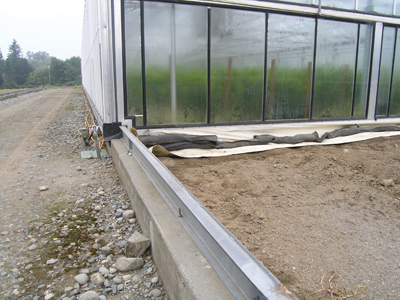
|
|
| A closeup of the rail line | |
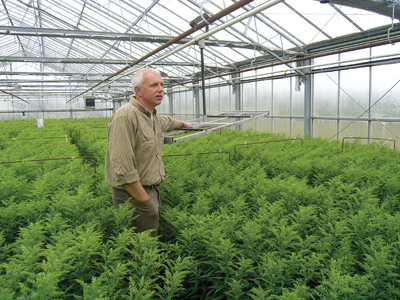 |
|
| The greenhouses feature monorail systems and forced air heaters, and have computerized environmental control, notes Gerard Smit. | |
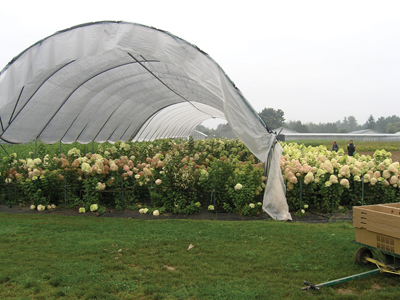 |
|
| Several high tunnel units are used to extend cropping seasons. They can be used with plastic or shading to assist with crop scheduling. |
SMIT NURSERY LTD.
Brothers Peter and Gerard own this business that was started by their
parents in 1984 as a daffodil-forcing farm. The focus has changed over
the years, and they now grow 1.8 million cut flowers each year,
specializing in perennials. Virtually all they produce is marketed
through the United Flower Growers auction.
Four rolling greenhouses are the centre of attention. The family has
extensive experience in using these structures – more common in the
Netherlands – to extend crop seasons. The first structure was built in
1986, followed by a second in 1998 and a third in 2000. The latest unit
was added about three years ago.
The greenhouses can be rolled over different crops at different times
of the year. With this system, they can have flowers in bloom earlier
or later than the traditional season; with both scenarios, the retail
prices are usually higher.
Each of the rolling greenhouses is 4,000 square feet. They have
monorail systems, forced air heaters, and computerized environmental
control. Energy curtains were added a few years when energy prices
began rising.
“They might cost more money (compared to traditional greenhouses),”
explained Gerard, “but they give us considerable versatility and
flexibility.”
Smit Nursery also uses high tunnel units to extend cropping seasons and
stagger shipping dates to better serve the market. They can be used
with plastic or shading to assist with crop scheduling. Each hoop in
the structure can be carried by only two people, making the units easy
to move about.
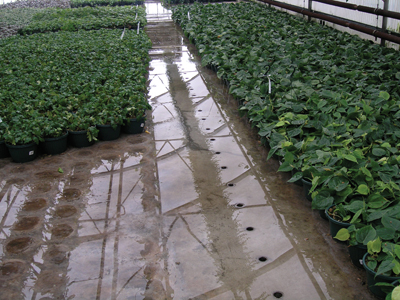
|
|
| This ebb-and-flood floor will fill in six minutes and drain in six minutes. The system ensures a thorough and consistent watering of each plant. | |
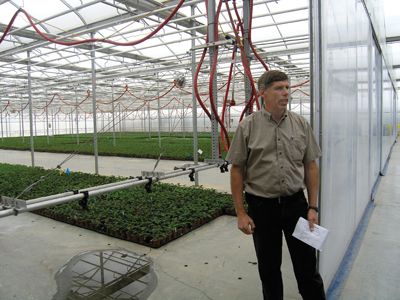 |
|
| Stan vander Waal describes the effectiveness of the watering booms in this propagation zone. “It offers great watering control.” | |
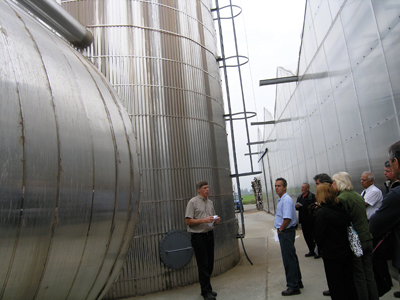 |
|
| Having sufficient heat storage allows the boilers to run steady and efficiently, said vander Waal. This system provides about one million litres of hot water storage. |
RAINBOW GREENHOUSES
Rainbow Greenhouses is a classic example of a major diversified
greenhouse operation that started quite small. Stan and Wilma vander
Waal started the company in 1985 as a business brokering potted plants
and cut flowers. In 1988, they purchased their current main site.
Included was 26,000 square feet of greenhouses, “in need of major
repair and upgrade.” What a difference two decades has made. The
business has grown to 1.1 million square feet of growing space at five
locations, including 450,000 square feet at the original site. They
have 110 full-time employees.
In addition to its own direct marketing efforts, complete with nine trucks, Rainbow also sells through
the UFG. Its prime markets are British Columbia, Alberta, Washington
and Oregon.
The tour featured a broad variety of plant material, including
tropicals. The company has got a very large catalogue. “Our goal is to
be a one-stop shopping solution (for customers),” said Stan while
leading the tour.
Rainbow incorporates a number of irrigation efficiencies, including
ebb-and-flood floors and benches, watering booms in its propagation
zone, and overhead basket systems with centralized watering locations.
The ebb-and-flood floors have in-ground heating, to help get plants
started. It’s not required for all crops, noted Stan. The heat also
dries up the floor.
Effective water treatment is essential with recirculation systems, said
Stan, “to manage diseases and bacteria in the system.” However, “you
can’t completely eliminate them, only control them.”
The company grew 500,000 poinsettias last fall, the first season they were grown in rice hulls.
Rainbow has a pair of biomass boilers, one of 300 horsepower and the
other of 500 horsepower. They’ve worked with biomass for several years,
overcoming initial problems with fuel consistency. Pine and cedar waste
material works well, with very little ash produced. It takes one to
three truckloads of waste wood a day to fuel the system, depending on
the season. They’re saving 75 per cent on heating costs, compared to
natural gas.
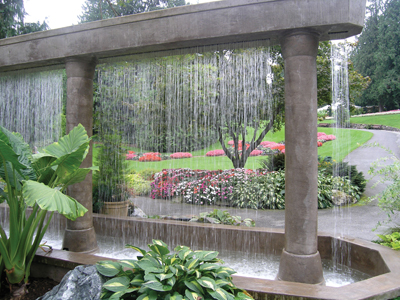
|
|
| The Waterfall Gardens is one of the most talked-about and photographed new displays. It’s known worldwide, with frequent international requests for the plans for the display. | |
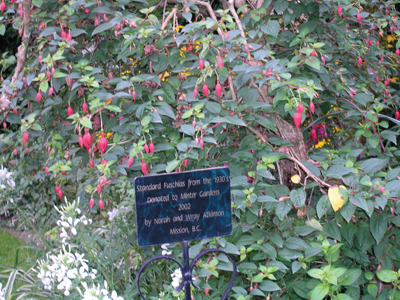 |
|
| Minter Gardens elicits a strong sense of community from British Columbian gardeners and horticulturists. Plants in this fuchsia display are rooted in a donation to the gardens. | |
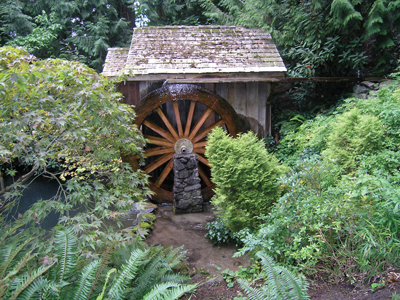 |
|
| This water wheel is a distinctive attraction within its display area. |
MINTER GARDENS
Minter Gardens is a 32-acre, world-class show garden nestled near the
base of Mount Cheam. Tour host Brian Minter said it was officially
opened on Mother’s Day in 1980. Some 80,000 visitors toured the grounds
the first year, and attendance has grown to 100,000 each year.
There are 12 different garden displays, all connected by a leisurely
meandering pathway system, and some noticeable changes in elevation.
The Gardens are becoming increasingly popular for weddings throughout the spring, summer and fall.
Tourists are especially drawn to the extremely rare display of Penjing Rock bonsai in the Chinese Garden.
Minter said the industry has to do more to attract generation X and
generation Y. “They are huge consumers,” he noted, “but we’re still not
relevant to their lifestyle. They represent an incredible opportunity
for the industry.”
For its part, Minter Gardens is developing a children’s garden to help attract young families to plants and gardening.
A conference speaker recently said North American garden centres are
about 10 to 20 years behind the best in Europe. “We don’t reinvest
enough in our businesses,” said Minter.
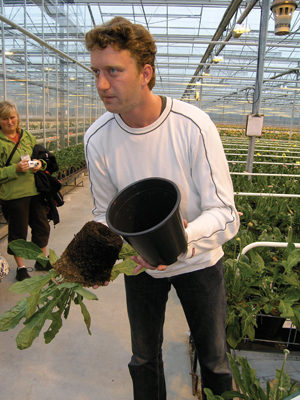
|
|
| Grower Wim Oudhuis shows the root development of a typical plant. Techni-Gro grows in cocopeat because of its excellent water drainage and oxygenation capacities. | |
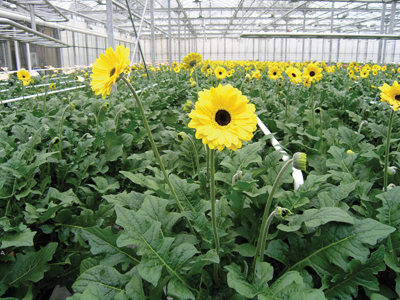 |
|
| Gerbera are continuing to grow in popularity as a cut flower. | |
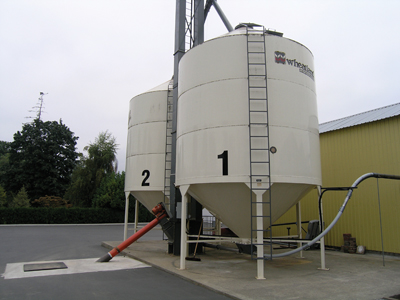 |
|
| The automated wood pellet bins. Techni-Gro has been heating with wood boilers for several years, with a gas boiler backup. |
TECHNI-GRO GREENHOUSES
Techni-Gro Greenhouses has become one of Canada’s leading cut gerbera
producers, with more than three million stems harvested each year.
William and Heleen Stolze have owned and operated the company since
1990.
They grow both regular and min gerberas, and rely almost entirely on
natural predators for pest control. “We rarely resort to chemical
control measures, ensuring our flowers are chemical-free,” notes the
company website. “When necessary, we strive to use the ‘softest’
chemical for a pest knock-down. This enables us to keep the balance of
other pest vs. beneficial populations.
The pots are filled with cocopeat. The large chunks are great for drainage and ensure optimal oxygenation of the rootzone.
Print this page